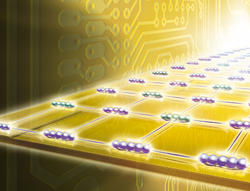Quantum antennae enable the exchange of quantum information between two separate memory cells located on a computer chip. (Graphics: Harald Ritsch)
The Austrian research group led by physicist Rainer Blatt suggests a fundamentally novel architecture for quantum computation. They have experimentally demonstrated quantum antennae, which enable the exchange of quantum information between two separate memory cells located on a computer chip. This offers new opportunities to build practical quantum computers.
Nature – Trapped-ion antennae for the transmission of quantum informatio
Six years ago scientists at the University of Innsbruck realized the first quantum byte – a quantum computer with eight entangled quantum particles; a record that still stands. “Nevertheless, to make practical use of a quantum computer that performs calculations, we need a lot more quantum bits,” says Prof. Rainer Blatt, who, with his research team at the Institute for Experimental Physics, created the first quantum byte in an electromagnetic ion trap. “In these traps we cannot string together large numbers of ions and control them simultaneously.” To solve this problem, the scientists have started to design a quantum computer based on a system of many small registers, which have to be linked. To achieve this, Innsbruck quantum physicists have now developed a revolutionary approach based on a concept formulated by theoretical physicists Ignacio Cirac and Peter Zoller. In their experiment, the physicists electromagnetically coupled two groups of ions over a distance of about 50 micrometers. Here, the motion of the particles serves as an antenna. “The particles oscillate like electrons in the poles of a TV antenna and thereby generate an electromagnetic field,” explains Blatt. “If one antenna is tuned to the other one, the receiving end picks up the signal of the sender, which results in coupling.” The energy exchange taking place in this process could be the basis for fundamental computing operations of a quantum computer.
Antennae amplify transmission
“We implemented this new concept in a very simple way,” explains Rainer Blatt. In a miniaturized ion trap a double-well potential was created, trapping the calcium ions. The two wells were separated by 54 micrometers. “By applying a voltage to the electrodes of the ion trap, we were able to match the oscillation frequencies of the ions,” says Blatt. “This resulted in a coupling process and an energy exchange, which can be used to transmit quantum information.” A direct coupling of two mechanical oscillations at the quantum level has never been demonstrated before. In addition, the scientists show that the coupling is amplified by using more ions in each well. “These additional ions function as antennae and increase the distance and speed of the transmission,” says Rainer Blatt, who is excited about the new concept. This work constitutes a promising approach for building a fully functioning quantum computer. “The new technology offers the possibility to distribute entanglement. At the same time, we are able to target each memory cell individually,” explains Rainer Blatt. The new quantum computer could be based on a chip with many micro traps, where ions communicate with each other through electromagnetic coupling. This new approach represents an important step towards practical quantum technologies for information processing.
a, Image of the two-layer segmented trap with gold-on-alumina electrodes. The electrodes are 250 µm wide with a pitch of 280 µm, and the ion–electrode spacing is 258 µm. b, Schematic close-up of the zone of interest.
More than 100 years ago, Hertz succeeded in transmitting signals over a few metres to a receiving antenna using an electromagnetic oscillator, thus proving the electromagnetic theory developed by Maxwell. Since this seminal work, technology has developed, and various oscillators are now available at the quantum mechanical level. For quantized electromagnetic oscillations, atoms in cavities can be used to couple electric fields. However, a quantum mechanical link between two mechanical oscillators (such as cantilevers or the vibrational modes of trapped atoms or ions) has been rarely demonstrated and has been achieved only indirectly. Examples include the mechanical transport of atoms carrying quantum information or the use of spontaneously emitted photons10. Here we achieve direct coupling between the motional dipoles of separately trapped ions over a distance of 54 micrometres, using the dipole–dipole interaction as a quantum mechanical transmission line11. This interaction is small between single trapped ions, but the coupling is amplified by using additional trapped ions as antennae. With three ions in each well, the interaction is increased by a factor of seven compared to the single-ion case. This enhancement facilitates bridging of larger distances and relaxes the constraints on the miniaturization of trap electrodes. The system provides a building block for quantum computers and opportunities for coupling different types of quantum systems.
If you liked this article, please give it a quick review on ycombinator or StumbleUpon. Thanks

Brian Wang is a Futurist Thought Leader and a popular Science blogger with 1 million readers per month. His blog Nextbigfuture.com is ranked #1 Science News Blog. It covers many disruptive technology and trends including Space, Robotics, Artificial Intelligence, Medicine, Anti-aging Biotechnology, and Nanotechnology.
Known for identifying cutting edge technologies, he is currently a Co-Founder of a startup and fundraiser for high potential early-stage companies. He is the Head of Research for Allocations for deep technology investments and an Angel Investor at Space Angels.
A frequent speaker at corporations, he has been a TEDx speaker, a Singularity University speaker and guest at numerous interviews for radio and podcasts. He is open to public speaking and advising engagements.



